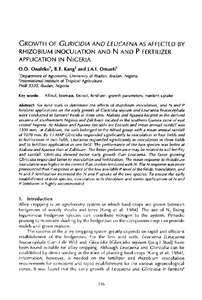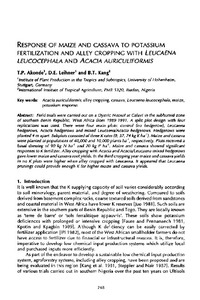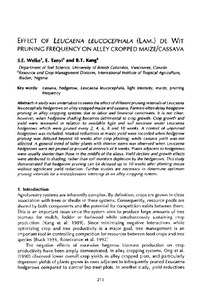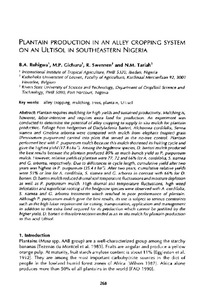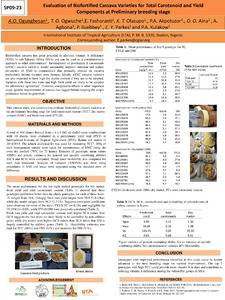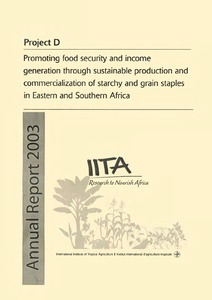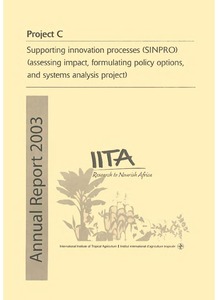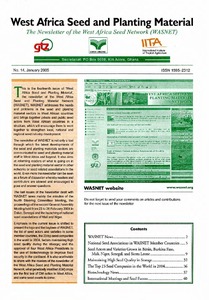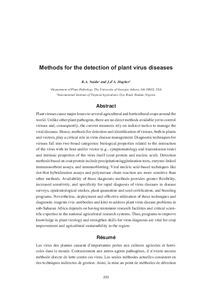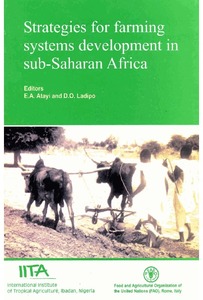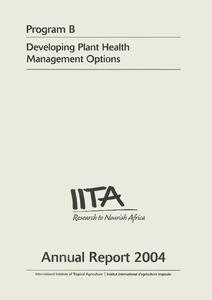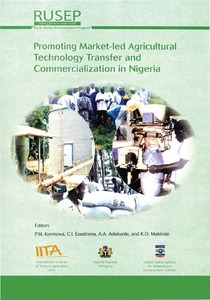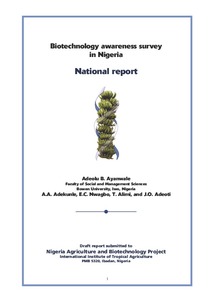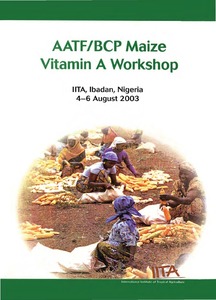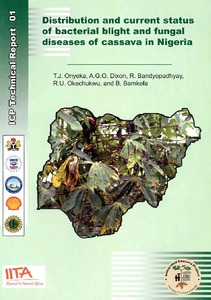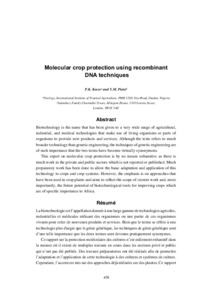Welcome to the International Institute of Tropical Agriculture Research Repository
Conference Documents: Recent submissions
Now showing items 561-580 of 726
-
Growth of Gliricidia and Leucaena as affected by Rhizobium inoculation and N and P fertilizar application in Nigeria
(1995)Six field trials to determine the effects of rhizobium inoculation, and N and P fertilizer applications on the early growth of Gliricidia sepium and Leucaena leucocephala were conducted in farmers' fields at three sites: Alabata and Ajaawa located in the derived savanna of southwestern Nigeria and Zakibiam located in the southern Guinea zone of ease central Nigeria. At Alabara and Ajaawa the soils are Entisols and mean annual rainfall was 1300 mm; at Zakibiam, the soils belonged to the Alfisol ... -
Response of maize and cassava to potassium fertilization and alley cropping with Leucaena leucocephala and Acacia auriculiformis
(1995)Field trials were carried out on a Dystric Nitosol at Calavi in the subhumid zone of southern Benin Republic, West Africa from 1989-1997. A split plot design with four replications was used. There were (our main plots: control (no hedgerow), Leucaena hedgerows, Acacia hedgerows and mixed Leucaena/Acacia hedgerows. Hedgerows were planted 4 m apart. Subplots consisted of three K rates (0, 37, 74 kg K ha-1). Maize and cassava were planted at populations of 40,000 and 10,000 plants ha-1, respectively. ... -
Effect of Leucaena leucocephala (Lam.) de wit pruning frequency on alley cropped maize/cassava
(1995)A study was undertaken to assess the effect of different pruning intervals of Leucaena leucocephala hedgerows on alley cropped maize and cassava. Farmers often delay hedgerow pruning in alley cropping systems due to labor, and financial constraints. It is not clear, however, when hedgerow shading becomes detrimental to crop growth. Crop growth and yield were measured in relation to available light and soil moisture under Leucaena hedgerows which were pruned every 2, 4, 6, 8 and 10 weeks. A control ... -
Plantain production in an alley cropping system on an Ultisol in southeastern Nigeria
(1995)Plantain requires mulching for high yields and sustained productivity. Mulching is, however, labor-intensive and requires extra land for production. An experiment was conducted to determine the potential of alley cropping to supply in situ mulch for plantain production. Foliage from hedgerows of Dactyladenia barteri, Alchornea cordifolia, Senna siamea and Gmelina arborea were compared with mulch from elephant (napier) grass (Pennisetum purpureum) carried into plots that served as the no-tree ... -
Pioneer woody species in Leucaena leucocephala and senna siamea hedgerows in a forest ecoysystem in southern Nigeria
(1995)Floral richness is an important feature of the tropical forest ecosystem. Large numbers of potentially useful volunteer species are usually present in crop fields in traditional farming systems. However; traditional farm lands are undergoing rapid deterioration as a result of increasing population pressure, with the resulting practice of continuous cultivation with little or no fallow. Consequently, many valuable woody species are at the verge of extinction. Work reported in the present study ... -
Alley cropping on an ultisol in southeastern Nigeria
(1995)An alley cropping trial was carried out on an acidic Typic paleudull in the humid forest zone of southeastern Nigeria using Three indigenous (Anthonotha macrophylla, Dactyladenia barteri, Harungana madagascariensis and two exotic (Calliandra calothyrsus and Flemingia macrophylla) hedgerow species. Early growth of Anthonotha was slow. Harungana and calliandra could not withstand repeated pruning and died 3 to 4 years after establishment. Dactyladenia performed better than Anthonata and Flemingia. ... -
Evaluation of biofortified cassava varieties for total carotenoid and yield components at preliminary breeding stage
(Global Cassava Partnership for the 21st Century - GCP21, 2018) -
On farm performance and farmers evaluation of cassava brown streak tolerant variety Kiroba in the Eastern zone of Tanzania
(2004)Cassava Brown Streak Disease (CBSD) is a very serious disease in many cassava growing areas of the Eastern zone of Tanzania. It is mainly confined to the lower elevations, mainly along the coast yield losses of up to 74% occur as a result of CBSD infection in some part of the Eastern zone. In the year 2001, a variety believed to be tolerant to CBSD was introduced in two villages Zogowale and Viziwaziwa in the Eastern zone in which CBSD is a big problem. The objective was to find out whether Kiroba ... -
Mycoherbicide for water hyacinth
(2003)A presentation of the theoretical approach and results of IMPECCA: International Mycoherbicide programme for Eichhornia crassipes ((Mart.) Solms) control in Africa, with particular emphasis on activities in West Africa. -
Association between zigzag stem habit and resistance/tolerance to cassava brown streak virus disease
(2004)Cassava is an important food staple in the coastal provinces of east and southern Africa. However, its production is adversely affected by cassava brown streak virus disease (CBSD). CBSD first reported from Amani, Tanzania in 1936, is now considered to be one of the major biotic constraints to cassava production especially in the coastal lowlands. Efforts to develop resistant varieties as the major control measure for CBSD started way back in the 1940s. in efforts to improve breeding efficiency, ... -
Prospects for breeding agronomically superior Musa with resistance or tolerance to BSV
(2003)The genetic improvement of banana and plantain has focused on breeding for resistance to black sigatoka. This has been quite successful, but the distribution of improved hybrids has been impeded by the outbvreak of Banana streak virus (BSV). Integration of viral sequences in Musa genomes make it difficult to apply commonly accepted principles for host-plant resistance. The short-term strategy of breeding programs at IITA was to address the BSV issue through a practical approach based on identification ... -
Economic losses experienced by smallscale farmers in Malawi due to cassava brown streak virus disease
(2003)Cassava is an important root crop in Malawi. It is the second most important food crop after maize. It is grown throughout the country as a food security crop, sack/cash crop, and as a staple food crop along the Lake Malawi. Is is a staple for over 39 % of the country’s population. Farmers are not benefiting as much as they might from cassava because they are faced with a number of constraints. These include: - inherent low yielding and late maturing local cultivars - pests and diseases ... -
Methods for the detection of plant viruse diseases
(2003)Plant viruses cause major losses to several agricultural and horticultural crops around the world. Unlike other plant pathogens, there are no direct methods available yet to control viruses and, consequently, the current measures rely on indirect tactics to manage the viral diseases. Hence, methods for detection and identifi cation of viruses, both in plants and vectors, play a critical role in virus disease management. Diagnostic techniques for viruses fall into two broad categories: biological ... -
Overview of viruses of legumes other than groundnut in Africa
(2003)Many legume species are grown in sub-Saharan Africa (SSA). In addition to groundnut (Arachis hypogaea L.), which has a major production area in West Africa, Cicer arietinum L. (chickpea), Glycine max (L.) Merr. (soybean), Vigna unguiculata (L.) Walp. (cowpea), Phaseolus spp. (bean), and Cajanus cajan (L.) Millsp. (pigeon pea) are widely grown in sub-Saharan Africa (Allen and Lenné 1998). The yield of these crops from sub-Saharan Africa in 2001 is given in Table 1 and, while it reflects the relative ... -
Cassava mosaic disease and its causal agents: the Nigeria situation
(2003)Highlights are presented on the status of knowledge about cassava mosaic disease (CMD) and its causal agents in Nigeria. The disease occurs in all the agroecologies where cassava is grown, from the humid forest in the south to the semiarid and arid agroecologies in the north. The severity is generally moderate but can be very severe on susceptible genotypes. A severe outbreak of the disease was recorded in the late 1980s in Akwa Ibom State in southeastern Nigeria and was curtailed through the use ... -
Cassava virus diseases in Africa
(2003)Cassava plays a key role in the food security of sub-Saharan Africa, but as a vegetatively propagated crop, it is particularly vulnerable to the effects of virus diseases and these therefore represent a major threat to the livelihoods of millions of Africans. Nine viruses have been isolated from African cassava, but only cassava mosaic geminiviruses (CMGs) and Cassava brown streak virus (CBSV) cause diseases of major economic signifi cance. In recent years, both CMGs and CBSV have come under ... -
An overview of viruses infecting Dioscorea yams in subSaharan Africa
(2003)Viruses of the genera Potyvirus, Potexvirus, Badnavirus, Cucumovirus, and Carlavirus infect yams of different species worldwide. These viruses cause a range of symptoms including mosaics, mottle, vein clearing, chlorosis, stunting, and distortion. These lead to a chronic and sometimes severe disease situation in all yam growing areas. In sub-Saharan Africa, where more than 90% of the world’s yams are produced, Yam mosaic virus (YMV), genus Potyvirus is an ubiquitous pathogen. It is the only ... -
Development and regional deployment of streak virus resistant maize germplasm: an overview
(2003)The Maize streak virus (MSV) disease has been one of the most devastating diseases of maize (Zea mays L.) in all the countries of West and Central Africa (WCA). For a long time, breeding for resistance to the disease was frustrating because of lack of facilities for uniform artifi cial inoculation. In 1975, a collaborative project involving the International Institute of Tropical Agriculture (IITA), the International Maize and Wheat Improvement Center (CIMMYT), and the national agricultural research ... -
Yam breeding
(2003)Yams (Dioscorea species of family Dioscoreaceae) are important for food, income, and sociocultural activities especially in West and Central Africa and account for about 93% of the world’s annual production of 38 million tonnes. Breeding of yams is focused primarily on the two dominant species, D. rotundata Poir. and D. alata L., and it is carried out within the context of improving yam-based systems. Constraints to productivity of cultivation and opportunities for improvement are identifi ed ... -
Molecular crop protection using recombinant DNA techniques
(2003)Biotechnology is the name that has been given to a very wide range of agricultural, industrial, and medical technologies that make use of living organisms or parts of organisms to provide new products and services. Although the term refers to much broader technology than genetic engineering, the techniques of genetic engineering are of such importance that the two terms have become virtually synonymous. This report on molecular crop protection is by no means exhaustive as there is much work in the ...

